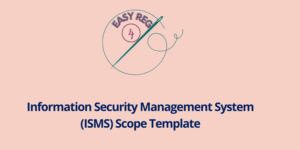One of the most important document related to ISO 27001 is related to the definition of the scope of an Information Security Management, or in other words the ISO 27001 scope. In the ever-evolving landscape of information security, ensuring robust measures to safeguard sensitive data is paramount for businesses worldwide.
We have been already discussing ISO 27001 requirements and, in the last years, with the huge increase of digital medical device and software related products, implementing a structured system to ensure security of the device and safety of the patient became of huge importance. Specifically, several topics were discussed like vulnerability management, asset management, and information security management system policy.
ISO 27001 offers a structured approach towards establishing, implementing, maintaining, and continually improving an Information Security Management System (ISMS). Central to the successful deployment of ISO 27001 is defining its scope, a crucial step that sets the boundaries and responsibilities for securing organizational assets. In this article, we delve into the intricacies of ISO 27001 scope, unraveling its significance and providing insights to navigate this essential aspect of information security management.
Understanding ISO 27001 Scope
At its core, the scope of ISO 27001 delineates the extent and boundaries of the ISMS within an organization. It defines the areas, assets, processes, and activities that fall under the purview of the ISMS, guiding the implementation of appropriate controls and measures to mitigate risks effectively. Establishing a well-defined scope is fundamental as it serves as the foundation upon which the entire information security framework is built.
Key Components of ISO 27001 Scope
Organizational Context: Begin by comprehensively understanding the organizational context, including the business environment, internal and external stakeholders, and the scope’s relevance concerning the company’s objectives and goals.
Assets Identification: Identify and catalog all information assets within the organization, including tangible assets like hardware, software, and infrastructure, as well as intangible assets such as intellectual property, sensitive data, and customer information.
Risk Assessment: Conduct a thorough risk assessment to identify potential vulnerabilities, threats, and risks associated with the identified assets. This step is critical in determining the scope boundaries by evaluating the impact and likelihood of risks on the organization.
Legal and Regulatory Requirements: Consider applicable legal and regulatory requirements pertinent to the organization’s industry and geographical location. Ensure that the scope encompasses compliance with relevant laws and standards, thus mitigating legal risks.
Business Processes: Evaluate all business processes and functions to ascertain their relevance to the ISMS. Determine which processes are integral to information security and should therefore be included within the scope.
Benefits of a Well-Defined ISO 27001 Scope
Focused Resource Allocation: By clearly delineating the scope, organizations can allocate resources more efficiently, directing efforts towards securing critical assets and processes essential for business operations.
Enhanced Risk Management: A well-defined scope enables organizations to identify and assess risks more effectively, facilitating the implementation of targeted controls and measures to mitigate potential threats.
Improved Compliance: Establishing a comprehensive scope ensures alignment with regulatory requirements and industry standards, thereby enhancing compliance and minimizing the risk of non-conformities.
Streamlined Implementation: Clarity in scope expedites the implementation process by providing a clear roadmap for deploying security controls, conducting audits, and monitoring compliance within the defined boundaries.
Heightened Stakeholder Confidence: A robust ISMS with a clearly defined scope instills confidence among stakeholders, including customers, partners, and regulatory bodies, demonstrating the organization’s commitment to information security.

ISO 27001 Scope Template
4EasyReg has developed a dedicated ISO 27001 ISMS Scope Template, ready to be amended and/or used within your organization. This template can be used a starting point for the organization and structure of your Information Security Management System and it can easily be adapted to any type of organization (not necessarily medical device companies).
The document shall include, at least, a clear definition of the ISMS scope, interested parties, processes and business units involved in the security-related processes, supply chain management and a clear definition of the responsibilities.
4EasyReg and ISO27001 / CyberSecurity Documentation
Given the importance of cybersecurity in today’s world and the significant amount of organization wishing to move forward ISO 27001 certification, 4EasyReg provides a series of articles and products aimed at supporting compliance efforts of medical device organisations. There are a lot of articles and free resources related to ISO 27001 certification an FDA cybersecurity requirements, such as:
- FDA requirements for threat model implementation
- Vulnerability disclosure
- Asset Management according to ISO 27001
- Business Continuity Plan
- and much more.
Furthermore, on our webshop, several templates and documentation focused on cybersecurity and related topics are available, for example:
a) For ISO 27001:
- Information Security Policy Template
- Incident Management Procedure
- Security Risk Assessment Template
- Encryption Policy Template
b) For Cybersecurity:
- Cybersecurity Risk Management Plan
- Threat Model Report Template
- Vulnerability Disclosure Policy Template
- Management of Cybersecurity Vulnerabilities
4EasyReg Newsletter
Do not hesitate to subscribe to our Newsletter:

